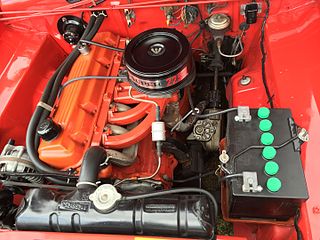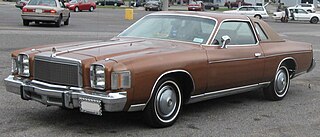Slant can refer to:
Slant can refer to:

The inline-six engine is a piston engine with six cylinders arranged in a straight line along the crankshaft. A straight-six engine has perfect primary and secondary engine balance, resulting in fewer vibrations than other designs of six or less cylinders.
A spider is a type of arthropod.
Currents, Current or The Current may refer to:
Challenger, Challengers, or The Challengers may refer to:

The Plymouth Barracuda is a two-door pony car that was manufactured by Chrysler Corporation from 1964 through 1974 model years.

Dodge Dart is a line of automobiles marketed by Dodge from the 1959 to 1976 model years in North America, with production extended to later years in various other markets.

The Slant-Six is the popular name for a Chrysler inline-6 internal combustion engine with an overhead valve reverse-flow cylinder head and cylinder bank inclined at a 30-degree angle from vertical. Introduced in 1959 for the 1960 models, it was known within Chrysler as the G-engine. It was a clean-sheet design that began production in 1959 at 170 cubic inches (2.8 L) and ended in 2000 at 225 cubic inches (3.7 L). It was a direct replacement for the flathead Chrysler straight six that the company started business with in 1925 until the old design was discontinued in the 1960s.

The Chrysler Valiant was a full-size car which was sold by Chrysler Australia between 1962 and 1981. Initially a rebadged locally assembled Plymouth Valiant from the United States, from the second generation launched in 1963, the Valiant was fully manufactured in Australia. It was sold locally but also in New Zealand and South Africa, with smaller numbers also exported to South-East Asia and the United Kingdom.
Town and Country may refer to:

The Chrysler Cordoba was first introduced as a full-sized luxury car based on the Chrysler Newport that was marketed during the 1970 model year.

The Dodge Diplomat is an American mid-size car that was produced by Dodge from 1977 to 1989. At launch, it shared a common design with the Chrysler LeBaron and for much of its later production run was the counterpart of the more upscale Chrysler Fifth Avenue and lower priced Plymouth Gran Fury. It was also sold in Mexico between 1981 and 1982 as the Dodge Dart, and in Colombia as the Dodge Coronet. The Diplomat was initially offered in a coupe and a sedan; in 1978, station wagons were added as replacements for the discontinued full-sized C-body wagons.

The Triumph slant-four is an inline four-cylinder petrol car engine developed by the Triumph Motor Company. It first appeared in 1968 in the Saab 99. The first Triumph model to use the engine did not appear until 1972. With an original capacity of 1.7 L, displacement grew over time to 2.0 L. Triumph production ended in 1981.
A garage is a covered structure built for the purpose of parking, storing, protecting, maintaining, and/or repairing vehicles. Specific applications include:

The Saab B engine is an inline four-cylinder car petrol engine developed by Saab Automobile. A redesign of the Triumph slant-four engine, the B engine displaced 2.0 L and first appeared in 1972. The B engine was used in the Saab 99 and 900 models. Saab began to phase the engine out in 1981.
The horizon is the line at which the sky and the Earth's surface appear to meet.

The Chrysler Hemi engines, known by the trademark Hemi or HEMI, are a series of American V8 gasoline engines built by Chrysler with overhead valve hemispherical combustion chambers. Three different types of Hemi engines have been built by Chrysler for automobiles: the first from 1951 to 1958, the second from 1964 to 1971, and the third beginning in 2003. Although Chrysler is most identified with the use of "Hemi" as a marketing term, many other auto manufacturers have incorporated similar designs. The engine block and cylinder heads were cast and manufactured at Indianapolis Foundry.
Slant-6, Slant 6, or Slant Six may refer to:

The Chrysler VIP is an automobile which was produced by Chrysler Australia from 1969 to 1971. It is an extended wheelbase, luxury variant of the Australian developed Chrysler Valiant.
Simon Tam is an American author, musician, activist, and entrepreneur. He is best known as the bassist and founder of the Asian American dance-rock band, the Slants, who won their case against the U.S. Patent & Trademark Office at the United States Supreme Court. The case, Matal v. Tam, was a landmark legal battle that clarified First Amendment rights in trademark law. The court ruled unanimously in Tam's favor, holding that trademark registrations may not be rejected under the Disparagement Clause of the Lanham Act (1946) since that would be considered viewpoint discrimination; this includes, as in Tam's case, trademarks using such language filed by members of minority groups who wish to reclaim slurs that would have been previously denied.

The Plymouth XNR is a concept car developed by Chrysler. It was designed by Virgil Exner, and first shown in 1960. Also called the XNR 500, the car is an open roadster with some asymmetric features, and was proposed as a sporty addition to the Plymouth model lineup, and as competition for the Chevrolet Corvette.